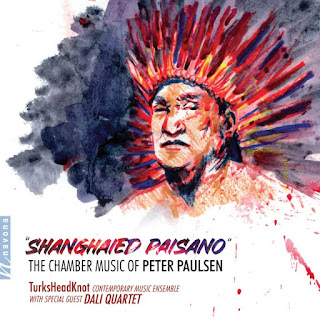Samuel Adams - "Current" album review
Samuel Adams - Current album review
Most noticeably, all of Current focuses on how unconventional usage of programmed electronics interact with the acoustic properties of live instruments.
Releasing September 8th on Other Minds Records, Current presents three pieces, two of which are premiere recordings, by award-winning composer Samuel Adams. The titular work, String Quartet No. 2, Current, is framed by two shorter pieces, one for violin and piano, the other, Shade Studies, a series of electronic etudes for piano. Most noticeably, all of Current focuses on how unconventional usage of programmed electronics interact with the acoustic properties of live instruments. Even though the music itself can be derogatorily labeled repetitive, Adams has established a unique individual way he can control sounds.
Opening with Adams' own version of a pandemic piece, Violin Diptych portrays the same general form and feelings of emptiness in two different movements. The first, "Playing Changes", uses the undulating repetitive figures which are common in Adams' music, peaking with a low electronic drone, grounding the uneasiness of the rocking violin lines. Violinist Karen Gomyo brings excitement and an indefatigable sense of playing to the work, never seeming to tire with Adams' continuous lines. When paralleled against "Changes Move", the music seems to comment and reflect back on the first movement, sorting out the tense progressions and reorganizing them into continuous scrawling lines for violin accompanied by an echoing piano echoing. Suddenly the piano grabs control of the violin, becoming the center of attention before letting Gomyo really shine with an ending expressive line twinged with Romanticism.
The titular work, String Quartet No. 2, Current, is broken in five parts, each exploring how resonance from the electronically triggered snare drum combines with the acoustic string quartet. Using large and small scale repetitions, Adams creates a musical form as a byproduct of his compositional process. Spektral Quartet is the perfect ensemble for Adams' sonic experimentation and the ensemble fully lives up to their renown work in contemporary music as one of their last featured recordings. The first movement's rocking chordal pillars can be described as nothing less than dizzying. The resultant feeling is a perfect example of how Adams uses resonance to create such engaging musical tension by doing next to nothing musically.
The resonating snare drum is a prominent feature of the entire quartet. When added with repetitive string parts, it heavily contributes to the literal sound of constantly moving currents. In fact, the underlying static buzz of the drum is the only musical aspect holding together the five movements. While all five sections are interesting experiments in sound, and interesting at first, the utter lack of development becomes tedious quite quickly. Besides the first movement, primarily due to its brevity, only the third movement engages enough to function successfully by itself. The slow, steady glissando of a high drone note finds strange ways to recontextualize the repeating swelling motif, first presented in the upper strings then again much lower to close off the music.
Shade Studies, which closes the album, is an older example of Adams' work from 2014. Expertly performed here by Conor Hanick, the studies are a set of simple yet luxurious experiments in combining the acoustic resonance of the piano with smooth sine tones. At first the electronics are seemingly unnoticeable, just barely out of ear's reach. Soon enough, waves grow out of Adams' spacey piano lines, collecting a thick tapestry of electronic dissonance which is never directly recognized until after it has completely dissipated.
© 2023 Brutal New Music Reviews




Comments
Post a Comment